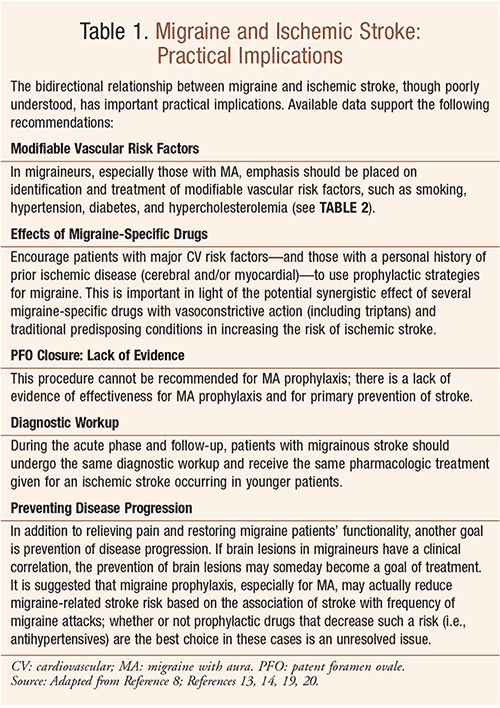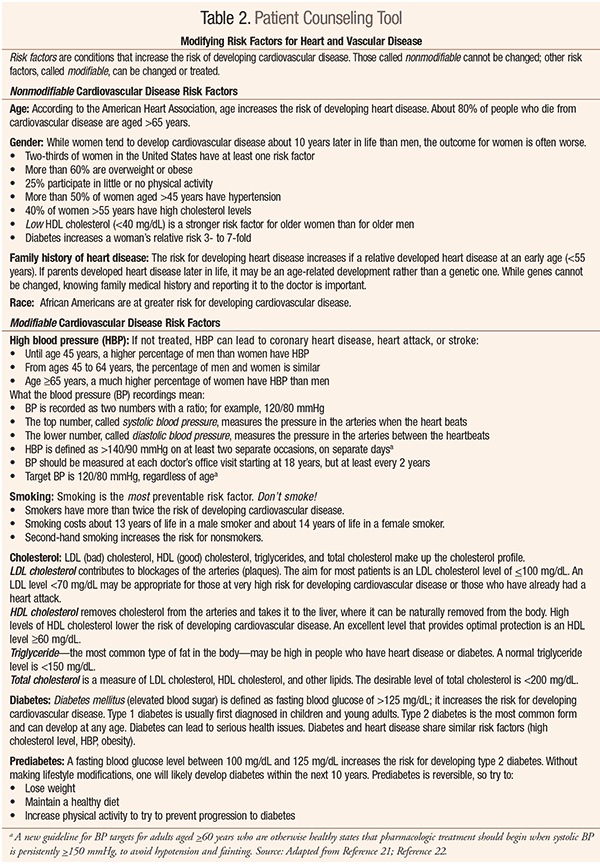While headache is a common complaint in the general population—remaining the most common neurologic disorder worldwide—it is reported less often by elderly patients.1 The prevalence of headache declines in older adults, yet it remains an extremely common condition in this age group.1 Furthermore, medication overuse continues to contribute to the etiology of chronic daily headache in elderly individuals, particularly in those who have a history of migraine headache.2 A significant proportion of the burden of migraine headache is underdiagnosed and undertreated in the general population; this is even more true among the elderly. Importantly, this condition is more likely to represent a serious pathology, such as transient ischemic attack (TIA) and ischemic stroke, in older adults.1
Migraine and Migraine With Aura
Classified as a primary headache disorder, migraine has two major subtypes, migraine without aura (MO) and migraine with aura (MA).3 MO is referred to as a clinical syndrome characterized by headache with particular features and related symptoms (i.e., unilateral location, pulsating quality, moderate or severe intensity, aggravation by routine physical activity, and association with nausea and/or photophobia and phonophobia).
MA is characterized by transient focal neurologic symptoms that usually precede or sometimes accompany a headache with migrainous features.4 Aura is a group of neurologic symptoms that may be visual (e.g., flashes of light), sensory (e.g., paresthesias), or motor (e.g., hemiparesis). MA may also cause language or brainstem disturbance; aphasia has also been reported.1 A headache usually manifests within 60 minutes of the end of the aura. MA may be confused with a TIA, and vice versa.1
While occurring in both sexes, migraine is predominantly found in females, with a cumulative lifetime prevalence of 43% in women and 18% in men.4 Migraine is episodic and diagnosed from the patient’s medical history; although it commonly commences around puberty, it may start at any age.5 While migraine can persist into later years, symptoms tend to improve with age.5,6
Evidence is strong regarding the link between migraine and the hormonal status of women; both the timing and frequency of migraine attacks are influenced by hormone-related events.7 The occurrence of migraine attacks may be influenced by the varying hormonal status of women through menarche, menstruation, pregnancy, and menopause; the use of oral contraceptives and hormone replacement therapy may precipitate migraine as well.7
As noted above, headache in older adults is more likely to represent a serious pathology.1 Migraine is strongly associated with cryptogenic (i.e., obscure or unknown origin) TIA and ischemic stroke, particularly at older ages; migrainous aura in the elderly individual presents an especially difficult diagnostic dilemma.8
Migraine and Ischemic Stroke: Association?
An association between migraine and ischemic stroke has been observed for many years, although the exact mechanisms by which migraine can lead to stroke are currently still under investigation.9 Migraine is associated with an increased stroke risk and is considered an independent risk factor for ischemic stroke in a particular subgroup of patients; it is related to stroke in several ways9,10:
• Ischemic stroke can develop as a complication of an attack of MA (so-called migrainous infarction).
• Epidemiological studies suggest that MA is a risk factor for ischemic stroke.
• A patent foramen ovale (PFO) is a well-known risk factor for stroke and seems to be associated with MA.9
Migraine and PFO
PFO is a common condition in stroke and migraine that could play a pathogenic role in both disorders.10 A bidirectional relationship between migraine and ischemic stroke, while still poorly understood, has important practical implications (TABLE 1).8 PFO, described as an interatrial communication remnant of the fetal circulation, is attributed to a failure in the fusion between septum primum and septum secundum; its prevalence is about 25% in the healthy adult population, and evidence indicates that PFO is significantly more common in patients who have experienced MA than in those without migraine.8 Researchers note that right-to-left cardiac shunt at rest through a PFO is more common in patients who have MA than in control patients with a PFO who do not have migraines; patients with migraine tend to have greater right-to-left shunts as compared with the non-migrainous population.8 While the mechanism underpinning this possible association was postulated but never demonstrated, researchers report that it suggests that interatrial communication may play a role in the pathogenesis of migraine.8

Of note, Spalice et al indicate that paradoxical embolism is suggested to be the causal link between migraine and PFO8; however, data available are insufficient to substantiate the hypothesis that migraine frequency (and, indirectly, ischemic stroke risk) is reduced by PFO closure. Although some patients who have had PFO closure for nonmigraine indications reported cessation or improvement of their migraine attacks after the procedure, the possibility of a triangular association between PFO, migraine, and ischemic stroke remains a matter of speculation, according to researchers.11-14
Hu et al report that dozens of observational studies and two meta-analyses have investigated the association of migraine with the risk of stroke, but their results have been inconsistent.15 The researchers aimed to quantitatively evaluate the relationship between migraine and stroke risk by performing a metaanalysis of prospective cohort studies, searching PubMed and Embase databases through July 2016. They noted that integrated epidemiological evidence supports the hypothesis that migraine should be associated with the increased risk of total stroke and ischemic stroke, but the relationship between migraine and the risk of hemorrhagic stroke is uncertain.15
Modifiable Vascular Risk Factors
Findings regarding an association between migraine and increased ischemic stroke risk underscore the importance of identifying high-risk migraineurs who have other modifiable stroke risk factors.16 Further studies of the effect of migraine treatment and modifiable risk-factor reduction on stroke risk in migraineurs are warranted.16 In migraine patients, especially those with MA, there should be an emphasis on identification and treatment of modifiable vascular risk factors, such as smoking, hypertension, diabetes, and hypercholesterolemia.8 TABLE 2 provides discussion points for counseling patients, their families, and their caregivers on the opportunities to participate in modifying risk factors for heart and vascular disease.
Increased Risk of Perioperative Stroke
A recent prospective hospital registry study found that surgical patients with a history of migraine are at increased risk for perioperative ischemic stroke and have an increased 30-day hospital readmission rate.17 The researchers recommend that migraine be considered in the risk assessment for perioperative ischemic stroke.
Risks in Older Migraineurs Who Smoke
A recent population-based cohort study of stroke incidence, in which patients (1,292 participants, mean age 68 ± 9 years) were assessed for migraine symptoms using a self-report questionnaire, found no association between migraine (with or without aura) and risk of either stroke or combined cardiovascular events.18 There was an interaction between migraine and current smoking, such that those who had migraine and smoked were at an increased risk. The researchers indicated that among smokers, migraine was associated with a threefold increased risk of stroke. In this racially/ethnically diverse cohort, the researchers did not find an association between migraine and the risk of either combined cardiovascular events or stroke in nonsmokers.
Conclusion
Headache remains an extremely common condition in elderly people, and care needs to be taken to rule out underlying pathology, particularly when an older adult presents to the healthcare provider for the first time. In migraine patients, especially those with MA, pharmacists should place emphasis on identification and treatment of modifiable vascular risk factors, such as smoking, hypertension, diabetes, and hypercholesterolemia. Counseling should extend beyond the patient and include family and caregivers to support patient self-efficacy.
REFERENCES
1. Saldanha GJF. Headache and facial pain. In: Fillit HM, Rockwood K, Woodhouse K, eds. Brocklehurst’s Textbook of Geriatric Medicine and Gerontology. 7th ed. Philadelphia, PA: Saunders Elsevier; 2010:466-477.
2. Prencipe M, et al. Prevalence of headache in an elderly population: attack frequency, disability, and use of medication. J Neurol. Neurosurg Psychiatry. 2001;70(3):377-381.
3. Headache Classification Committee of the International Headache Society (IHS) The International Classification of Headache Disorders, 3rd edition (beta version) Cephalalgia. 2013;33:629-808.
4. Stewart WF, Wood C, Reed ML, et al. AMPP Advisory Group Cumulative lifetime migraine incidence in women and men. Cephalalgia. 2008;28:1170-1178.
5. Goadsby PJ, Lipton RB, Ferrari MD. Migraine—current understanding and treatment. N Engl J Med. 2002;346(4):257-270.
6. Stewart WF, Linet MS, Celentano DD, et al. Age- and sex-specific incidence rates of migraine with and without visual aura. Am J Epidemiol. 1991;134(10):1111-1120.
7. Ripa P, Ornello R, Degan D, et al. Migraine in menopausal women: a systematic review. Int J Womens Health. 2015;7:773-782.
8. Spalice A, Del Balzo F, Papetti L, et al. Stroke and migraine is there a possible comorbidity? Ital J Pediatr. 2016;42:41.
9. Katsarava Z, Weimar C. Migraine and stroke. J Neurol Sci. 2010; 299(1-2):42-44.
10. Agostoni E, Fumagalli L, Santoro P, et al. Migraine and stroke. Neurol Sci.2004; 10(25 Suppl 3):S123-S125.
11. Guegan-Massardier E, Lucas C. Migraine and vascular risk. Rev Neurol (Paris). 2013;169(5):397-405.
12. Tana C, Tafuri E, Tana M, et al. New insights into the cardiovascular risk of migraine and the role of white matter hyperintensities: is gold all that glitters? J Headache Pain. 2013;14(1):9.
13. Davis D, Gregson J, Willeit P, et al. Patent foramen ovale, ischemic stroke and migraine: systematic review and stratified meta-analysis of association studies. Neuroepidemiology. 2013;40(1):56-67.
14. Kurth T, Diener HC. Migraine and stroke: perspectives for stroke physicians. Stroke. 2012;43(12):3421-3426.
15. Hu X, Zhou Y, Zhao H, et al. Migraine and the risk of stroke: an updated meta-analysis of prospective cohort studies. Neurol Sci. 201;38(1):33-40.
16. Spector JT, Kahn SR, Jones MR, et al. Migraine headache and ischemic stroke risk: an updated meta-analysis. Am J Med. 2010;123(7):612-624.
17. Timm FP, Houle TT, Grabitz SD, et al. Migraine and risk of perioperative ischemic stroke and hospital readmission: hospital based registry study. BMJ. 2017;356:i6635.
18. Monteith TS, Gardener H, Rundek T, et al. Migraine and risk of stroke in older adults: northern Manhattan study. Neurology. 2015; 85(8):715-721.
19. Agostoni E, Rigamonti A. Migraine and small vessel diseases. Neurol Sci. 2012;33(Suppl 1):S51-S54.
20. Laurell K, Lundström E. Migrainous infarction: aspects on risk factors and therapy. Curr Pain Headache Rep. 2012;16(3):255-260.
21. Center for Prevention of Heart and Vascular Disease. University of California San Francisco. Non-modifiable and modifiable risk factors. http://healthyheart.ucsf.edu/heartdisease-riskfactors.shtml. Accessed February 13, 2017.
22. Quaseem A, Wilt TJ, Rich R, et al. Pharmacologic treatment of hypertension in adults aged 60 years or older to higher versus lower blood pressure targets: a clinical practice guideline from the American College of Physicians and the American Academy of Family Physicians. Ann Intern Med. 2017;166(6)430-437.
To comment on this article, contact rdavidson@uspharmacist.com.






